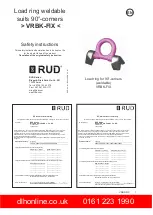
2
VRBK-FIX
Before initial usage of the RUD-VRBK-FIX,
please read carefully the safety instruc-
tions. Make sure that you have understood
all subjected matters.
Non-observance can lead to serious per-
sonal injuries and material damage and
eliminates warranty.
1 Safety instructions
ATTENTION
Wrong positioned or damaged weld-on
lifting points as well as improper use can
lead to injuries of persons and damage at
property, when load falls down.
Please check all lifting points carefully
before every usage.
RUD-llifting points VRBK-FIX must only be used by
instructed and competent persons considering BGR
500 / DGUV 100-500, and outside Germany noticing
the country specific statutory regulations.
2 Intended use of the VRBK-FIX
RUD-Lifting points VRBS-FIX must only be used for
the assembly at the load or at lifting means.
They are designed and intented to attach lifting
means.
RUD Lifting points can also be used as lashing points
to attach lashing means.
RUD-lifting points must only be used in the hereby
specified case of operation.
3 Assembly- and instruction manual
3.1 General information
• Capability of temperature usage:
When used at higher temperatures the working
load limit (WLL) of the lifting point must be reduced
as follows:
-
-20°C up to 200°C
no reduction
-
200°C up to 300°C
minus 10 %
-
300°C up to 400°C
minus 25 %
Temperatures exceeding 400°C are prohibited!
• RUD-lifting points VRBK-FIX must not be used
with aggressive chemicals such as acids, alkaline
solutions and their vapours.
• Please mark mounting position of lifting point with
a coloured contrast paint for better visibility.
• VRBK-FIX will be delivered with a pink powder
coated lifting ring.
• VRBS-FIX includes a protected positioned clam-
ping spring, inside the weld-on block. The spring
holds the weld-on blocks together with the ring and
creates at the same time a radial clamping function.
• VRBK-FIX will be delivered as a complete assem-
bled unit.
3.2 Hints for the assembly
Basically essential:
• The material construction to which the lashing point
will be attached should be of adequate strength to
withstand forces during lifting without deformation.
The weld-on material must be suitable for welding
and the contact areas must be free from dirt, oil,
colour, ect. The material of the forged welding block
is: N (1.0577+N (St52-3))
• The position of the lifting points must be carried
out in such a way that unintended movement like
turning or flipping will be avoided.
•
For single leg lifts,
the lifting point should
be vertically above the centre of gravity of
the load
•
For two leg lifts,
the lifting points must be
equidistant to/or above the centre of gravity
of the load.
•
For three and four leg lifts,
the lifting
points should be arranged symmetrical
around the centre of gravity, in the same
plane if possible.
• Load symmetry:
Determine the necessary WLL of each lifting point
for a symmetrical load by using the following phy-
sical calculation formula:
Number of load bearing strands:
Symmetric
Unsymmetric
two leg
2
1
three / four leg
3
1
Chart 1: Load bearing strands
(compare to chart 2)
• Check finally the correct assembly (see chapter 4,
Inspection criteria).
3.3 Hints for the welding
The welding should only be carried out according to
DIN EN ISO 9606-1 or AWS Standards by an autho-
rized and certified welder.
Verification of the used weld-on material must be
checked with the supplier of the welding electrodes.
W
LL
= necessary WLL of lifting point /
single strand (kg)
G
= weight of load (kg)
n
= number of load bearing strands
ß
= inclination angle of single stra
W
LL
=
G
n x cos ß
























